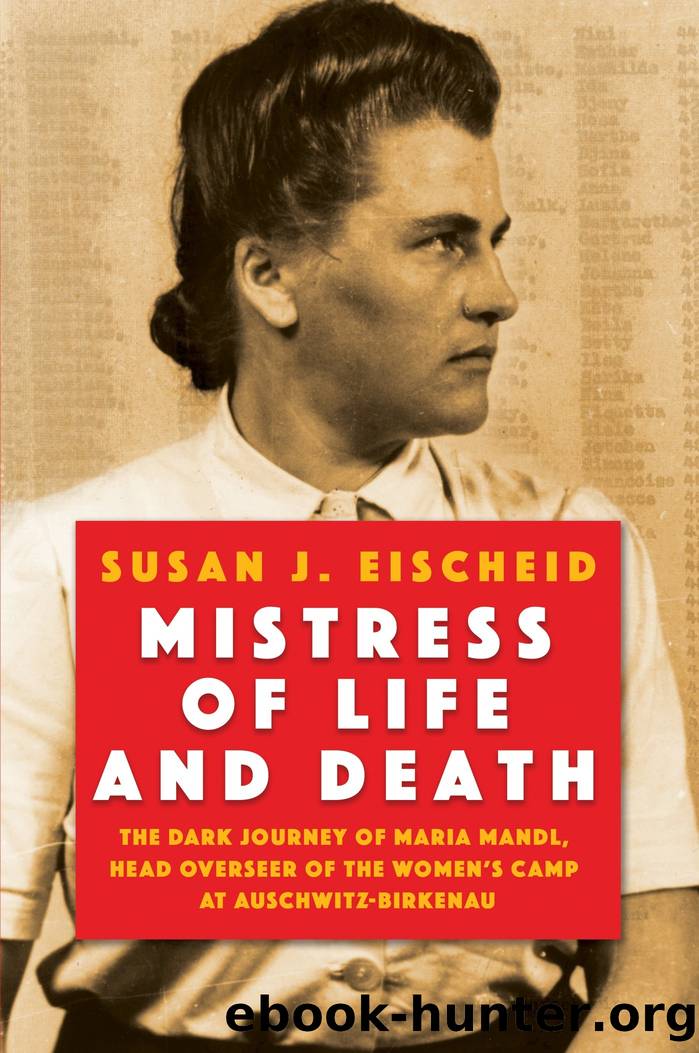Mistress of Life and Death by Susan J. Eischeid

Author:Susan J. Eischeid [Eischeid, Susan J.]
Language: eng
Format: epub
Publisher: Citadel Press
Published: 2023-11-07T00:00:00+00:00
CHAPTER 66
Montelupich
I have felt the same with my own imprisonment which has lasted two years. I have now lived through everything the prisoners complained about during my years of service.
âMARIA MANDL
AFTER ARRIVING IN KRAKOW, MARIA was held in Montelupich Prison, where she would remain for the rest of her life. There she awaited the trial that would determine her fate. SS Untersturmführer Hans Münch, imprisoned at Montelupich the same time as Maria, remembered that the rough times at Auschwitzââstrange as it may soundââwere easier to bear than the times immediately after warâs end. âWhen I finally ended up in a Polish prison, things got really badâto be confined in a very small space, in a narrow cell with many Auschwitz guards and leaders,â all of them loudly proclaiming and discussing their innocence. âWe suffered some severe emotional stresses.â
As German prisoners, both Mandl and Münch received better than average treatment, although both were also subject to various indignities by fellow inmates who were survivors of Auschwitz and the camps.
Montelupich, present day. The large prison dominates its neighborhood. Surrounding streets are very busy, congested. We are admitted to the prison ahead of a long line of civilians waiting for visiting hoursâour official visit request categorized as high security. Escorted to the directorâs office, we discover a tall, high-walled corner room, filmed for the movie Schindlerâs List. The guard confides that everyone finds the décor ugly but it must be retained âbecause itâs famous.â
The director is in his late forties, tall and good-looking. Keen brown eyes appraise us. He wears an open-necked shirt and talks with his hands; his manner is gracious, accommodating, charming, urbane.
We sit around a table, drinking tea. A PR man also sits in, offering information. He is younger, chatty, and very observant. We evidently make a good impression because all doors open for us. The translator urges the author to âdrink in the experience.â She does.
The director has a sense of humor. âI must call ahead to make sure they donât shoot me!â He, in contrast to everyone else we see, does not carry a gun. We are given a tour with few restrictions. We are allowed to take photos.
The corridors are long and dark, with black-and-maroon floor tiles dating from Mariaâs time. We pass through heavy security. The cell block has no interior windows; there are visible pipes on the top of the corridors, some thick, some thin, with intermittent dim lights and peeling paint near the ceiling.
The smell overwhelms, a combination of musty bodies, confined spaces, nervous perspiration, despair.
Our guide shows us a cell currently occupied by two men. It seems impossibly smallâthe same size as in Mandlâs day. These prisoners are kept here twenty-three hours a day. The translator apologizes to them for our intrusion and the author is ashamed she has been oblivious to their discomfortâdistracted by the drinking in of this experience.
There is a fairly large courtyard not currently used by prisoners, who are now consigned to a rooftop exercise area. Some executions were
Download
This site does not store any files on its server. We only index and link to content provided by other sites. Please contact the content providers to delete copyright contents if any and email us, we'll remove relevant links or contents immediately.
| Afghan & Iraq Wars | American Civil War |
| American Revolution | Vietnam War |
| World War I | World War II |
Waking Up in Heaven: A True Story of Brokenness, Heaven, and Life Again by McVea Crystal & Tresniowski Alex(37678)
Empire of the Sikhs by Patwant Singh(22982)
We're Going to Need More Wine by Gabrielle Union(18975)
Hans Sturm: A Soldier's Odyssey on the Eastern Front by Gordon Williamson(18491)
Leonardo da Vinci by Walter Isaacson(13190)
The Radium Girls by Kate Moore(11935)
Tools of Titans by Timothy Ferriss(8230)
Educated by Tara Westover(7948)
How to Be a Bawse: A Guide to Conquering Life by Lilly Singh(7397)
Permanent Record by Edward Snowden(5749)
The Last Black Unicorn by Tiffany Haddish(5563)
The Rise and Fall of Senator Joe McCarthy by James Cross Giblin(5233)
Promise Me, Dad by Joe Biden(5090)
The Wind in My Hair by Masih Alinejad(5036)
A Higher Loyalty: Truth, Lies, and Leadership by James Comey(4851)
The Crown by Robert Lacey(4732)
The Iron Duke by The Iron Duke(4295)
Joan of Arc by Mary Gordon(4023)
Stalin by Stephen Kotkin(3885)
